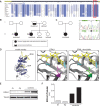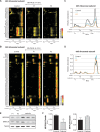A homozygous missense mutation in ERAL1, encoding a mitochondrial rRNA chaperone, causes Perrault syndrome
- PMID: 28449065
- PMCID: PMC5965403
- DOI: 10.1093/hmg/ddx152
A homozygous missense mutation in ERAL1, encoding a mitochondrial rRNA chaperone, causes Perrault syndrome
Abstract
Perrault syndrome (PS) is a rare recessive disorder characterized by ovarian dysgenesis and sensorineural deafness. It is clinically and genetically heterogeneous, and previously mutations have been described in different genes, mostly related to mitochondrial proteostasis. We diagnosed three unrelated females with PS and set out to identify the underlying genetic cause using exome sequencing. We excluded mutations in the known PS genes, but identified a single homozygous mutation in the ERAL1 gene (c.707A > T; p.Asn236Ile). Since ERAL1 protein binds to the mitochondrial 12S rRNA and is involved in the assembly of the small mitochondrial ribosomal subunit, the identified variant represented a likely candidate. In silico analysis of a 3D model for ERAL1 suggested that the mutated residue hinders protein-substrate interactions, potentially affecting its function. On a molecular basis, PS skin fibroblasts had reduced ERAL1 protein levels. Complexome profiling of the cells showed an overall decrease in the levels of assembled small ribosomal subunit, indicating that the ERAL1 variant affects mitochondrial ribosome assembly. Moreover, levels of the 12S rRNA were reduced in the patients, and were rescued by lentiviral expression of wild type ERAL1. At the physiological level, mitochondrial respiration was markedly decreased in PS fibroblasts, confirming disturbed mitochondrial function. Finally, knockdown of the C. elegans ERAL1 homologue E02H1.2 almost completely blocked egg production in worms, mimicking the compromised fertility in PS-affected women. Our cross-species data in patient cells and worms support the hypothesis that mutations in ERAL1 can cause PS and are associated with changes in mitochondrial metabolism.
© The Author 2017. Published by Oxford University Press.
Figures





Similar articles
-
Human ERAL1 is a mitochondrial RNA chaperone involved in the assembly of the 28S small mitochondrial ribosomal subunit.Biochem J. 2010 Sep 15;430(3):551-8. doi: 10.1042/BJ20100757. Biochem J. 2010. PMID: 20604745 Free PMC article.
-
Mutations in mitochondrial histidyl tRNA synthetase HARS2 cause ovarian dysgenesis and sensorineural hearing loss of Perrault syndrome.Proc Natl Acad Sci U S A. 2011 Apr 19;108(16):6543-8. doi: 10.1073/pnas.1103471108. Epub 2011 Apr 4. Proc Natl Acad Sci U S A. 2011. PMID: 21464306 Free PMC article.
-
Expanding the Clinical and Molecular Spectrum of HARS2-Perrault Syndrome: Identification of a Novel Homozygous Missense Variant in the HARS2 gene.Genet Test Mol Biomarkers. 2021 Aug;25(8):528-539. doi: 10.1089/gtmb.2021.0092. Genet Test Mol Biomarkers. 2021. PMID: 34406847
-
An Application of NGS for Molecular Investigations in Perrault Syndrome: Study of 14 Families and Review of the Literature.Hum Mutat. 2016 Dec;37(12):1354-1362. doi: 10.1002/humu.23120. Epub 2016 Oct 7. Hum Mutat. 2016. PMID: 27650058 Review.
-
LARS2-Perrault syndrome: a new case report and literature review.BMC Med Genet. 2020 May 18;21(1):109. doi: 10.1186/s12881-020-01028-8. BMC Med Genet. 2020. PMID: 32423379 Free PMC article. Review.
Cited by
-
Genetic etiology of Perrault syndrome in Iranian families: first report from Iran and literature review.J Appl Genet. 2025 Jan 23. doi: 10.1007/s13353-025-00940-0. Online ahead of print. J Appl Genet. 2025. PMID: 39847269
-
A Case Report of Auditory Neuropathy Due to TWNK Gene Mutations.J Int Adv Otol. 2025 Jan 27;21(1):1-6. doi: 10.5152/iao.2025.241648. J Int Adv Otol. 2025. PMID: 39936838 Free PMC article. Review.
-
Biallelic variants in DAP3 result in reduced assembly of the mitoribosomal small subunit with altered intrinsic and extrinsic apoptosis and a Perrault syndrome-spectrum phenotype.medRxiv [Preprint]. 2024 Aug 21:2024.08.19.24312079. doi: 10.1101/2024.08.19.24312079. medRxiv. 2024. Update in: Am J Hum Genet. 2025 Jan 2;112(1):59-74. doi: 10.1016/j.ajhg.2024.11.007. PMID: 39371131 Free PMC article. Updated. Preprint.
-
Translation Fidelity and Respiration Deficits in CLPP-Deficient Tissues: Mechanistic Insights from Mitochondrial Complexome Profiling.Int J Mol Sci. 2023 Dec 15;24(24):17503. doi: 10.3390/ijms242417503. Int J Mol Sci. 2023. PMID: 38139332 Free PMC article.
-
Mitochondrial Chaperones in the Brain: Safeguarding Brain Health and Metabolism?Front Endocrinol (Lausanne). 2018 Apr 26;9:196. doi: 10.3389/fendo.2018.00196. eCollection 2018. Front Endocrinol (Lausanne). 2018. PMID: 29755410 Free PMC article.
References
-
- Perrault M., Klotz B., Housset E. (1951) [Two cases of Turner syndrome with deaf-mutism in two sisters]. Bull. Mem. Soc. Med. Hop. Paris, 67, 79–84. - PubMed
-
- Nishi Y., Hamamoto K., Kajiyama M., Kawamura I. (1988) The Perrault syndrome: clinical report and review. Am. J. Med. Genet., 31, 623–629. - PubMed
-
- Gottschalk M.E., Coker S.B., Fox L.A. (1996) Neurologic anomalies of Perrault syndrome. Am. J. Med. Genet., 65, 274–276. - PubMed
-
- Fiumara A., Sorge G., Toscano A., Parano E., Pavone L., Opitz J.M. (2004) Perrault syndrome: evidence for progressive nervous system involvement. Am. J. Med. Genet. A, 128A, 246–249. - PubMed
-
- Pierce S.B., Walsh T., Chisholm K.M., Lee M.K., Thornton A.M., Fiumara A., Opitz J.M., Levy-Lahad E., Klevit R.E., King M.C. (2010) Mutations in the DBP-deficiency protein HSD17B4 cause ovarian dysgenesis, hearing loss, and ataxia of Perrault Syndrome. Am. J. Hum. Genet., 87, 282–288. - PMC - PubMed
Publication types
MeSH terms
Substances
Supplementary concepts
Grants and funding
LinkOut - more resources
Full Text Sources
Other Literature Sources
Molecular Biology Databases

